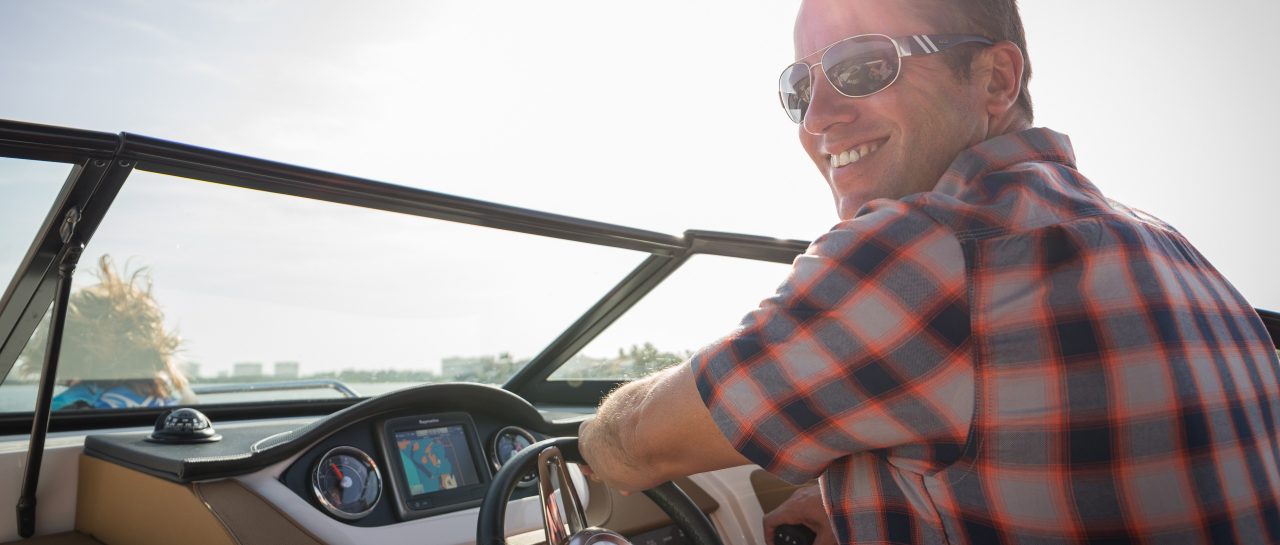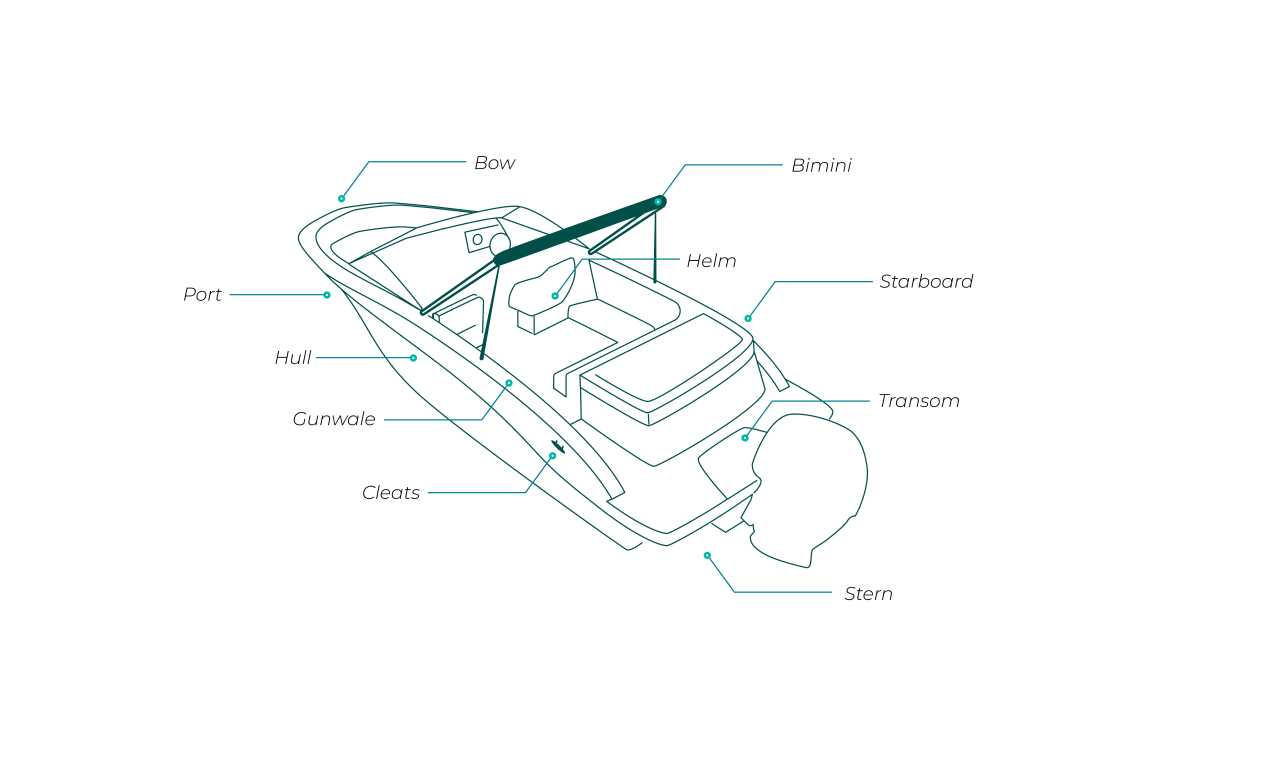NAVIGATION AND CONTROL

Operating Your Boat the Smart Way
Whether you've never operated a boat before, or want to send a note to the friends you're going boating with, thinking about operating a boat can often be intimidating for the first-time boater. With the right knowledge and practice, however, operating a boat can be easy and fun!
This guide intends to de-mystify the basic elements and set you on the right course. In addition to this guide, there are several courses and on-water training options that you can make use of, like BoatClass, to become the confident captain of your own boat.
Before we get into the specifics of operating a boat, it is important to get familiarized with some basic boating terms:

Boating Terminology
Bow: Front section of the boat.
Stern: Rear section of the boat.
Port: Left side of the boat.
Starboard: Right side of the boat.
Helm: The area where the captain controls the vessel including steering, throttle and other associated switching.
Transom: The rear-most part of the vessel, where the engine (if outboard) is mounted.
Hull: The main body of the boat.
Gunwale: Upper edge of the side of the boat.
Bilge: The lowest inner part of the boat designed to collect water.
Keel: The beam on the bottom of the boat that runs down the middle from bow to stern.
Cleats: These are the metal devices installed around the perimeter of the boat used for attaching ropes/lines.
Bimini: A canvas sunshade with a retractable metal structure
Knots: The speed on water is measured in knots. One knot is equal to one nautical mile per hour. One Nautical Mile is ~1.15 miles; so a boat moving at 35 knots is equal to ~40 miles per hour.
Now, let’s look at some of the key functions for operating a boat:
Key Boating Functions
Throttle
Some boats have separate gear and throttle controls; others have a combined lever. It’s essential that you throttle smoothly and make small incremental changes to the speed. You can easily lose control of the boat if you make any sudden or excessive changes. Before shifting gears from forward to reverse or vice-versa, make sure to pause in the neutral position for a few seconds.
Trim
You will get the best handling of the boat when it runs parallel to the waterline. Trimming the engine’s angle allows you to adjust the position of the bow. If you trim the engine’s angle down, the bow will drop. Conversely, if the angle is trimmed up, the bow will rise. An angle that reduces the surface of hull in the water will create less drag and a smooth ride. It is advisable to have the trim down before you start the engine and then gradually raise the trim angle up as the speed increases and then find the right trim angle to reduce chop and maintain speed.
Maintaining Speed & Right of Way
You must maintain a safe speed that allows you to stop or maneuver when required. Detailed right of way and channel navigation rules exist and should be looked up and understood (especially as they apply to your local body of water) before embarking on a boating day.
Docking
A common mistake is to have the boat in gear right up to the dock impact or to slow the boat down at the last moment using the reverse gear with added power. You should maintain proper approach speed as you come to a gentle stop at the dock.
Approach the dock at a slight angle, as it allows for temporary change in wind conditions.
When you are 3 to 4 boat lengths from the dock, start using intermittent power.
Repeat this sequence of Power – Neutral – Glide- Assess, as you creep toward the dock. It is advisable to avoid over-steering and to not use any more prop thrust than is required.
When you get to within 1 boat length of the dock, turn the steering wheel hard over away from the dock to swing the stern in, while remaining parallel to the dock.
Turn the steering wheel over hard toward the dock while putting the engine in reverse for 1 to 2 seconds.
This should bring the boat to a gentle stop while continuing to draw the stern up to the dock.
Crossing Over
“Crossing over” the wake can be a scary proposition for boaters. Improper wake crossing is the second leading cause of personal injury to boaters, occurring due to crossing at high speeds or approaching the wake from the wrong angle.
In order to safely cross the wake of another boat:
Alert your passengers - The minute you realize you will be crossing a wake, let your passengers know. Make sure they are all securely seated and aware.
Move away from the wake - The further you are away from the boat that is producing the wake, the smaller the wake becomes. Be sure to stay within the channel and be aware of other boat activity in the area.
Slow down - If your boat is on plane, reduce your speed to where the boat just comes off plane. This will lift the bow up and help to create a cushioned effect on the wake.
Approach the wake at a 45-degree angle - Do NOT turn into the wake, but continue heading parallel to the other boat. This allows the boat to “roll” a bit over the wake versus “jumping over” it.
Re-Accelerate - Once you’ve crossed the wake, re-accelerate to return the boat back on plane.
Anchoring
Maybe you’ve arrived at your favorite fishing spot or you want to have a casual on-the-water meal - if you’re out on a boat and you want to stop, you’ll need to hold your position with an anchor.
Here are the anchoring basics you’ll need to be familiar with:
Determine Scope - This is the length of line needed for the depth of water that you are in. If you are stopping for lunch and the winds are light, use a ratio of 5 to 1 of the water depth. (Example: If you are in 10 feet of water, your scope should be 50 feet) If you are staying overnight and the winds are strong, use a ratio of 7 to 1. Generally, the longer the scope, the better your anchor will hold.
Measure the Line - You can do this by using your arm span, which is usually the same as your height. When you reach your desired length, cleat that point on the line to the bow of your boat.
Boat Positioning - Determine where you want your boat’s final position to be. Then drive your boat toward the direction that the wind is coming from, the same distance as the “scope”. (Example: If you have measured 50 feet of line, then drive 50 feet from your final position)
Drop the Anchor - Gently lower the anchor into the water. Do not throw or toss it. Then, as the wind moves your boat, let the line out hand over hand. Remember you’ve already tied off your line, so the boat will stop automatically.
Secure - Make sure your anchor is securely embedded in the bottom. Put the boat in reverse, creating a gentle reverse thrust. This draws the anchor deeper into the bottom, which creates more resistance with the surrounding bottom material.
Verify – Verify the anchor is engaged by monitoring GPS position or by looking at two objects that form a line off the port/starboard side, such as a pier piling and a building, that form a line to see if they are moving (because you are!) or remain in a line.


